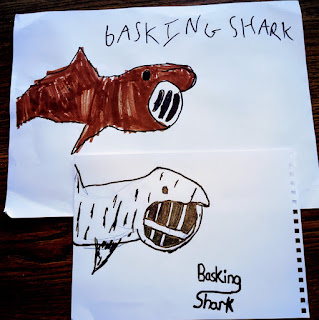Sharks at 7 & 3/4: British Sharks
So this was a golden opportunity. August being a five week month, I had the chance to refilm episode three of Sharks @ 7 & 3/4 and get back on track for episode four next month. But the small window of opportunity I had vanished. I feel like the boat for refilming has been missed but rather than abandon this episode entirely, I am going to break this episode down here. The kids did some really great pictures, it's not their fault I fail at filming. So I'm going to showcase their beautiful pictures, share some facts and get my act together for the next episode.
Basking Sharks
 |
| Top: Dylan's. Bottom: Addy's |
- The 2nd biggest shark alive today.
- They are filter feeders, meaning they eat plankton.
- They feed with their mouths wide open. They filter 1.5 million litres per hour and catch the microscopic plankton on their gill rakers. See those structures inside the mouths the kids drew? Those are the gill rakers.
- Their name comes from appearing to bask in the sun.
- Their livers weigh up to 2,000kg. These help the basking sharks float. This is a common feature amongst sharks, but not nearly as big as basking shark livers.
- They are a type of Mackeral Shark. These include: Great White, Goblin, Thresher, and Megamouth Sharks.
Small Spotted Catshark
 | |
| Left: Dylan's. Right: Addy's |
- These sharks are common in British waters and often referred to dogfish.
- Not to be confused with the Dogfish species of shark.
- Small Spotted Catsharks are Ground Sharks. This species includes: Swell-, Leopard, and Weasel Sharks.
- They are colourful, with patterns and beautiful markings which the kid have demonstrated fantastically. Dylan insisted his was coca-cola coloured.
- They are names for their catlike eyes.
Thresher Shark
 |
| Top: Dylan's. Bottom: Addy's |
- There are three species of Thresher Shark: Common, Peagic, and Big Eye.
- They have a distinct long tail, used to herd their prey and then whip them to stun. Sometimes they even co-ordinate their attacks in a group to maximise efficiency.
- Their tail is 50% of their body length. Overall body length is around the 3m mark.
- They have a big body but a small mouth, so they eat small prey.
- The Common Thresher live by the coast.
- Pelagic Threshers live in the open sea.
- Big Eye Threshers live in deep water. They are named for their big eyes, which can reach up to 10cm in diameter.
- Thresher Sharks are considered to be cunning sharks. In Ancient Greece, they were named "fox sharks" for their cunning nature.
So what are we going to do next time on Sharks @ 7 & 3/4? I'll let Addy tell you.
'Til next time!



Comments
Post a Comment